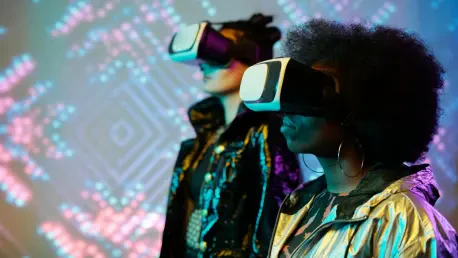In the bustling heart of Las Vegas, a city synonymous with spectacle and innovation, a quiet revolution is unfolding within the walls of the University of Nevada, Las Vegas (UNLV). At the Lied Library, the newly launched Dreamscape Learn VR center, which opened its doors in September, is redefining the educational landscape through the power of virtual reality. This cutting-edge facility immerses students in dynamic simulations where academic concepts come to life, transforming subjects like biology and environmental science into thrilling adventures. Far from a mere gimmick, this initiative signals a broader shift toward interactive learning, positioning Las Vegas as an unexpected leader in educational technology. As traditional classrooms struggle to keep pace with modern engagement demands, UNLV’s bold experiment offers a tantalizing glimpse into how technology can bridge that gap, making education as captivating as the city’s famous Strip.
Pioneering Immersive Learning with Virtual Reality
The essence of UNLV’s Dreamscape Learn center lies in its ability to merge education with immersion, creating a learning environment that feels more like an adventure than a lecture. Through a partnership with Dreamscape Learn, a company with ties to Hollywood storytelling, students dive into narrative-driven VR simulations directly linked to their academic curricula. Imagine a scenario where learners embark on quests reminiscent of blockbuster films, solving complex problems like locating a hidden artifact while applying scientific principles. These experiences demand real-time critical thinking and teamwork, ensuring that engagement isn’t just superficial but deeply tied to educational outcomes. This approach reimagines how knowledge is absorbed, proving that learning can be both entertaining and rigorous in equal measure, setting a new standard for higher education.
Beyond the thrill of virtual exploration, the impact on student motivation at UNLV is palpable and measurable. Reports from participants highlight a renewed sense of purpose, with many describing the VR simulations as challenges with tangible stakes that make coursework feel relevant. Unlike traditional methods where concepts can seem abstract, these simulations place students in virtual ecosystems or historical reenactments, allowing them to interact with their studies in a visceral way. This hands-on application not only reinforces retention but also fosters a collaborative spirit among peers as they navigate scenarios together. As a result, the center is carving out a space where academic rigor meets the excitement of discovery, offering a model that could inspire institutions far beyond the Nevada desert to rethink their teaching strategies.
Las Vegas: A Growing Epicenter for VR Innovation
Las Vegas has long been celebrated as a playground for entertainment, but its emergence as a hub for virtual reality innovation is a newer, equally compelling narrative. UNLV’s VR center is a cornerstone of this transformation, complemented by the city’s existing immersive offerings like the AREA15 complex, which showcases interactive experiences. This synergy between education and entertainment is unique to the city, where VR attractions on the Strip—think virtual skydives or high-stakes drone battles—echo the problem-solving essence of academic simulations. Such parallels suggest a future where lessons learned in commercial VR could inform educational tools, amplifying the city’s role as a testing ground for technology that blurs the line between fun and learning.
Moreover, technological advancements are fueling this momentum, with recent industry updates pointing to enhanced haptic feedback and AI-driven personalization in VR systems. These innovations make virtual environments more lifelike, enabling students to explore intricate scenarios, from climate change impacts in digital landscapes to pivotal historical events. Las Vegas, with its knack for spectacle, is ideally positioned to leverage these developments, potentially integrating them into both classroom settings and tourist experiences. This dual application could create a feedback loop, where educational VR benefits from entertainment-driven tech, cementing the city’s status as a leader in this space and inspiring broader adoption across diverse sectors.
Global Surge and Market Potential of VR in Education
The integration of virtual reality into education is not merely a local trend but part of a sweeping global movement, with Las Vegas at the forefront through UNLV’s initiatives. Current market analyses project the AR/VR education sector to reach an impressive $14.2 billion by 2028, reflecting an unprecedented demand for immersive learning solutions. This growth underscores a shift in how educational content is delivered, moving away from passive absorption to active participation. At UNLV, students are already experiencing this firsthand, with VR turning complex subjects into interactive challenges that heighten focus and drive. Such outcomes validate the investment in this technology, highlighting its potential to redefine academic engagement on a worldwide scale.
Adding to this momentum are emerging trends that point to an even more transformative future for VR in education. Industry discussions and social media platforms buzz with ideas like AI-generated virtual worlds that adapt to individual learning needs and micro-degrees delivered entirely through VR platforms. These innovations suggest a landscape where education becomes more accessible and tailored, breaking down traditional barriers of time and location. For a city like Las Vegas, already steeped in cutting-edge tech, these developments offer a chance to lead by example, showcasing how VR can revolutionize not just how students learn, but also how skills are acquired and certified in a rapidly evolving job market. This global surge positions the technology as a cornerstone of future learning systems.
Navigating Challenges and Seizing Opportunities
While the promise of VR in education is undeniable, significant challenges remain in ensuring its widespread adoption, even at forward-thinking institutions like UNLV. The high cost of quality VR equipment poses a risk of deepening the digital divide, limiting access for underfunded schools or students from disadvantaged backgrounds. To counter this, UNLV has forged partnerships with technology firms to subsidize hardware, a step in the right direction but not yet a universal solution. Addressing this barrier requires broader industry and government collaboration to make VR tools affordable, ensuring that the benefits of immersive learning are equitably distributed across diverse communities and educational settings.
Another critical hurdle lies in preparing educators to effectively integrate VR into their teaching methods, a process that demands time and resources. Without proper training, the technology’s potential could remain untapped, as faculty might struggle to align simulations with learning objectives. However, Las Vegas’s unique blend of entertainment and education offers a distinct opportunity to overcome these obstacles. By drawing inspiration from the city’s commercial VR experiences, educational models can evolve, potentially sparking nationwide interest. Strategic alliances between academia, tech developers, and entertainment sectors could pave the way for innovative solutions, turning challenges into stepping stones for a more inclusive and impactful VR-driven educational landscape.
Reflecting on a Visionary Leap Forward
Looking back, the launch of UNLV’s Dreamscape Learn VR center marked a pivotal moment in reimagining education within the vibrant context of Las Vegas. This facility demonstrated how virtual reality could captivate students by turning academic pursuits into immersive journeys, blending entertainment with purpose. The synergy between the city’s flair for innovation and its academic ambitions showcased a model that balanced technological advancement with real-world application. Challenges like cost and training were acknowledged, yet the proactive steps taken through partnerships hinted at scalable solutions. As this initiative unfolded, it became clear that the intersection of education and VR held transformative power, setting a precedent for others to follow. Moving forward, the focus should shift to expanding access through collaborative funding and enhancing educator support, ensuring that this high-tech educational upgrade becomes a blueprint for global institutions eager to inspire the next generation.









